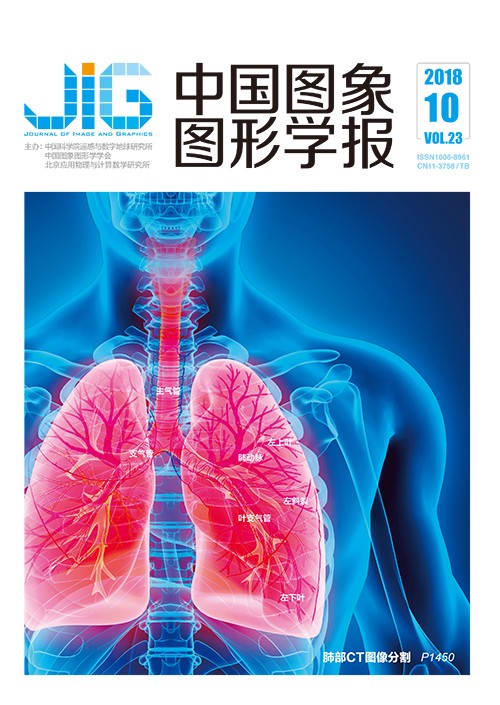
糖尿病性视网膜图像的深度学习分类方法
摘 要
目的 糖尿病性视网膜病变(DR)是目前比较严重的一种致盲眼病,因此,对糖尿病性视网膜病理图像的自动分类具有重要的临床应用价值。基于人工分类视网膜图像的方法存在判别性特征提取困难、分类性能差、耗时费力且很难得到客观统一的医疗诊断等问题,为此,提出一种基于卷积神经网络和分类器的视网膜病理图像自动分类系统。方法 首先,结合现有的视网膜图像的特点,对图像进行去噪、数据扩增、归一化等预处理操作;其次,在AlexNet网络的基础上,在网络的每一个卷积层和全连接层前引入一个批归一化层,得到一个网络层次更复杂的深度卷积神经网络BNnet。BNnet网络用于视网膜图像的特征提取网络,对其训练时采用迁移学习的策略利用ILSVRC2012数据集对BNnet网络进行预训练,再将训练得到的模型迁移到视网膜图像上再学习,提取用于视网膜分类的深度特征;最后,将提取的特征输入一个由全连接层组成的深度分类器将视网膜图像分为正常的视网膜图像、轻微病变的视网膜图像、中度病变的视网膜图像等5类。结果 实验结果表明,本文方法的分类准确率可达0.93,优于传统的直接训练方法,且具有较好的鲁棒性和泛化性。结论 本文提出的视网膜病理图像分类框架有效地避免了人工特征提取和图像分类的局限性,同时也解决了样本数据不足而导致的过拟合问题。
关键词
Automated classification of diabetic retinal images by using deep learning method
Li Qiong, Bai Zhengyao, Liu Yingfang(School of Information Science and Engineering, Yunnan University, Kunming 650500, China) Abstract
Objective Diabetic retinopathy(DR) is a serious eye disease that causes blindness.The retinal pathological image is an important criterion for diagnosing eye diseases,and the accurate classification of retinal images is a crucial step taken by doctors in developing personalized treatment plans.The automated classification of diabetic retinopathy images has significant clinical values.The traditional image classification methods based on manually extracted features have problems,including complex retinal image processing,discriminative features extraction difficulties,poor classification performance,time-consuming,and difficult objective and consistent diagnoses.In this paper,an improved deep convolutional neural network based on AlexNet and a deep classifier are proposed to realize automated diabetic retinopathy image classification.Method First,training the retinal samples is insufficient because retinal images contain much noise,and the differences between retinal pathological images at adjacent stages are small.These prevent the application of convolutional neural networks in retinal images classification,and retinal images should be preprocessed before they are used as training samples.Preprocessing mainly includes retinal image denoising,enhancement,and normalization.The small number of retinal images and data imbalance at different stages are solved by data enhancement.Second,the feature extraction network is designed based on the network structure of AlexNet.The data distribution is changed during the training process.Hence,a batch normalization layer is introduced before every convolutional layer and fully connected layer of the AlexNet network to produce a new deep network,which we call the BNnet network.The introduction of a batch normalization layer can accelerate the convergence of the network,improve the classification accuracy of the obtained model,and reduce the need for a dropout layer.The BNnet network is a complex deep convolutional neural network,which not only serves as a feature extraction network for retinal images but also effectively suppresses data distribution changes in the training process.In this work,the BNnet network is pre-trained using the ILSVRC2012 dataset based on the transfer learning strategy,and the obtained model is migrated to the enhanced diabetic retinopathy dataset for further study to capture the distinguishing features.Finally,a classifier is designed based on the fully connected layer,which can map the learned deep features to the sample label space.The classifier is composed of the fully connected,ReLU,and dropout layers and is applied in learning to partition a diabetic retinopathy status to no DR,mild DR,moderate DR,severe DR,and proliferative DR.Result We designed four groups of comparative experiments to fully describe the effects of the different depths of neural network and the different training methods,the introduced batch normalized layer,and data preprocessing of the experimental results.The experimental results show that the more layers the network has,the more features are learned with sufficient training samples,and the classification performance of the pre-trained network is better than the traditional direct training method.Moreover,the proposed BNnet neural network and training method can capture the differences of various stages of diabetic retinopathy with a classification accuracy of up to 93%,outperforming other methods.The introduction of the batch normalization layer can control the data distribution changes during the training process and improve the recognition rate.In the case of insufficient retinal image samples,the adoption of transfer learning and data enhancement strategies is good for extracting deep discriminative features for classification.Hence,a deep classifier that is composed of fully connected layers can accurately distinguish the stage when a retinal image is located,indicating that the obtained deep features based on BNnet and transfer learning can provide suitable information for classifiers to accurately classify retinal images into five categories.Conclusion We use deep learning methods to achieve the automatic classification of retinal images.We also present a new diabetic retinopathy classification framework that mainly benefits from three important components:the image preprocessing stage,the deep features extraction stage that is based on transfer learning strategies and BNnet neural networks,and the stable classification stage.Intensive dropout and ReLU are used to suppress the over-fitting problem of the deep learning algorithm when the training samples are insufficient.Experimental results show that deep features combined with the proposed methods can provide suitable information for the construction of the most accurate prediction mode,predict diabetic retinopathy status,and effectively avoid the limitations of manual feature extraction and image classification.This method has relatively better robustness and generalization,and it can be widely used for various image classification problems.In future studies,we will likely develop a real-time computer-aided diagnosis system for diabetic retina images based on the above mentioned approach.
Keywords
diabetic retinopathy image classification convolution neural network deep learning transfer learning deep features
|



 中国图象图形学报 │ 京ICP备05080539号-4 │ 本系统由
中国图象图形学报 │ 京ICP备05080539号-4 │ 本系统由